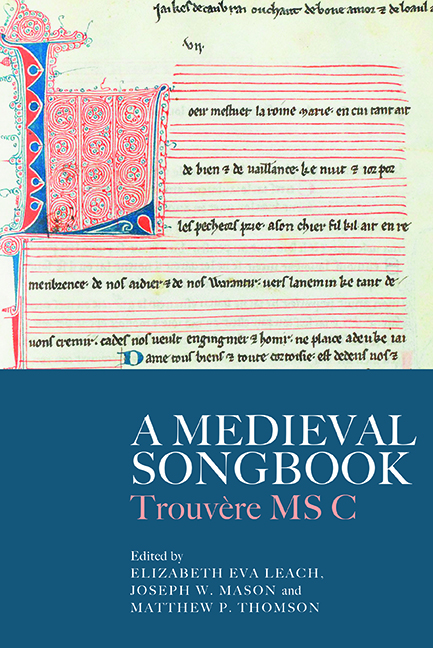Book contents
- Frontmatter
- Contents
- List of Illustrations
- List of Music Examples
- List of Tables
- List of Contributors
- Acknowledgements
- Abbreviations
- Editorial Practices
- Introduction
- Chapter 1 The Trouvère Manuscripts of the Burgerbibliothek Bern
- Chapter 2 The Lorraine Repertoire of C
- Chapter 3 Chansonnier C: Contents, Stemmatic Position, Particularities
- Chapter 4 A Note on the Decoration of C and its Artistic Context
- Chapter 5 Author Ascriptions and Genre Labels in C
- Chapter 6 Common Exemplars of U and C
- Chapter 7 Shared Small Sources for Two Early Fourteenth-Century Metz Chansonniers?
- Chapter 8 The Legacy of Thibaut de Champagne in C
- Chapter 9 Strategies of Appropriation in Jacques de Cambrai's Devotional Contrafacts
- Chapter 10 Jeux-Partis and their Contrafacts in C
- Chapter 11 C and Polyphonic Motets: Exemplars, Adaptations, and Scribal Priorities
- Appendix: List of Songs in C
- Bibliography
- Index of Sources
- Index of Songs
- General Index
- Studies in Medieval and Renaissance Music
Chapter 9 - Strategies of Appropriation in Jacques de Cambrai's Devotional Contrafacts
Published online by Cambridge University Press: 26 May 2022
- Frontmatter
- Contents
- List of Illustrations
- List of Music Examples
- List of Tables
- List of Contributors
- Acknowledgements
- Abbreviations
- Editorial Practices
- Introduction
- Chapter 1 The Trouvère Manuscripts of the Burgerbibliothek Bern
- Chapter 2 The Lorraine Repertoire of C
- Chapter 3 Chansonnier C: Contents, Stemmatic Position, Particularities
- Chapter 4 A Note on the Decoration of C and its Artistic Context
- Chapter 5 Author Ascriptions and Genre Labels in C
- Chapter 6 Common Exemplars of U and C
- Chapter 7 Shared Small Sources for Two Early Fourteenth-Century Metz Chansonniers?
- Chapter 8 The Legacy of Thibaut de Champagne in C
- Chapter 9 Strategies of Appropriation in Jacques de Cambrai's Devotional Contrafacts
- Chapter 10 Jeux-Partis and their Contrafacts in C
- Chapter 11 C and Polyphonic Motets: Exemplars, Adaptations, and Scribal Priorities
- Appendix: List of Songs in C
- Bibliography
- Index of Sources
- Index of Songs
- General Index
- Studies in Medieval and Renaissance Music
Summary
The late thirteenth-century Hennuyer trouvère Jacques de Cambrai (active c. 1260–90) occupies a place in C which mitigates the near-total obscurity surrounding his person. C is the only chansonnier that transmits his complete corpus which, though rather modest at twelve songs, is noteworthy for a number of reasons. His pieces embrace a variety of genres: love songs, devotional songs, and a single pastourelle; and his metrics and imagery show him to be a master of his craft. But it is his devotional writing in particular which has attracted the attention of scholars, as the pious register dominates his repertoire, with Marian songs comprising 58% of his output.
Jacques's predilection for Marian lyric found favour with the compilers of C, who placed his devotional songs first in every alphabetic section of the codex in which they appear. This privileged position afforded Jacques special treatment by the rubricator (see Table 9.1), who systematically marked the opening song(s) of each letter with an annotation confirming their pious theme: ‘de Nostre Dame’ (thirteen occurrences) or ‘de Deu’/‘de Nostre Signor’ (three occurrences). But Jacques's Marian pieces are distinguished by an additional navigational tool: the identification of the secular sources of six of the seven of his pious contrafacts, all of which are recorded in C. No other poet featured in the codex is honoured in this way. It is therefore generally accepted that Jacques's entries in C were copied from a now lost libellus of his songs. Jacques stands out, furthermore, for being one of the last trouvères to write devotional lyrics modelled on the courtly chanson. The beginnings of the shift to the devotional serventois, which marked the fourteenth-century evolution of Marian song, may already be visible in some of Jacques's songs, but at the time C was assembled, he represented the courtly devotional tradition at its apex.
Scholars of courtly lyric who have turned their attention to Marian song have come to see this genre as a subtle exercise in intertextual listening. Marian lyric at its inception was composed by courtly trouvères whose secular and devotional love songs are strikingly similar in theme and language.
- Type
- Chapter
- Information
- A Medieval SongbookTrouvère MS C, pp. 158 - 173Publisher: Boydell & BrewerPrint publication year: 2022
- 1
- Cited by

